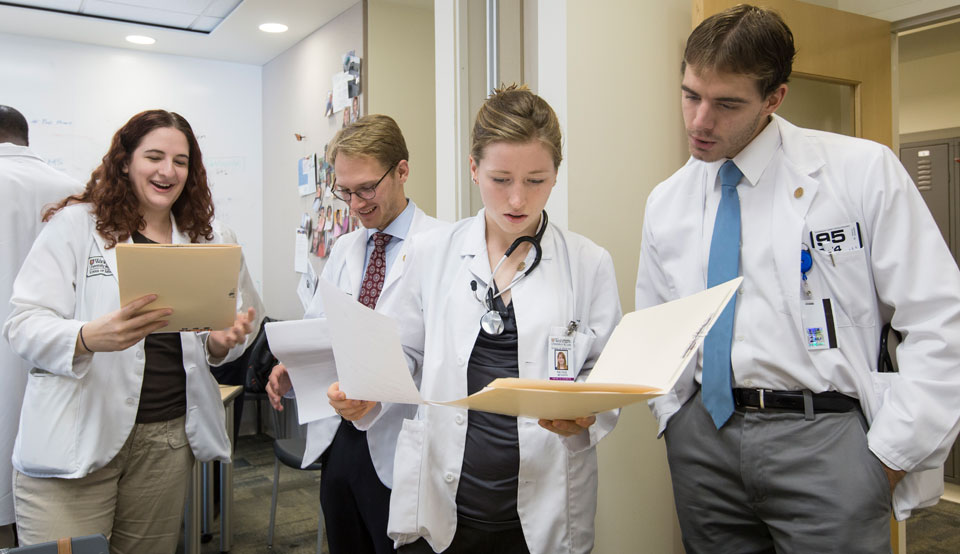
Inspired by
Saturday
The Saturday Neighborhood Health Clinic makes a difference in the lives of its patients and the medical students who care for them.
By Kristina Sauerwein
The first line started 17 years ago: Men and women shivering on an overcast Saturday in January in a partly abandoned swath of St. Louis City.
Only 10 degrees outside and not even 9 a.m., the underserved and uninsured waited by the nondescript building in the Forest Park Southeast neighborhood. They might have coughed or ached or itched, but all were hopeful for the chance to see a doctor.
For free.
The line has continued for almost every Saturday morning since, serving as a constant in the neighborhood throughout the year’s changing seasons and the community’s ongoing revitalization efforts.
The wait is for the Saturday Neighborhood Health Clinic, which operates on a first-come, first-served basis from 9 a.m. to noon. Students at Washington University School of Medicine run the clinic with help from a volunteer board-certified physician.
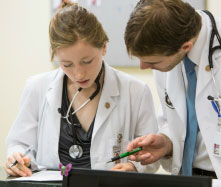
Experiencing public health firsthand
Housed in the Family Health Care Center on Manchester Avenue, the federally qualified clinic offers no-cost, episodic health services similar to those available at a primary care provider’s office: treatment of acute or chronic medical conditions, preventative care, vaccinations, women’s health care, physical exams and prescription refills, often free or at a reduced cost. It does not provide pediatric or dental care but refers patients to organizations that can help.
Despite the high demand, the Saturday clinic only has the funding, staffing and space to help the first nine patients in line.
“It is heart-wrenching to turn people away,” said Will Ross, MD, MPH, associate dean for diversity and associate professor of medicine at Washington University School of Medicine who also started the Saturday clinic, chartering it in September 1996 and opening it the following winter. “A lot of people who come to clinic have jobs to go to on Saturdays or take buses to get here. Bus fares, even a few dollars, can be a big expense, and then to have to turn them away after all their efforts to get here, well, gosh, it’s hard.”
Better to focus on the many lives it helps — up to 400 a year and approximately 7,200 since its inception — and all with an annual budget of $25,000. “A lot of these people have gone years without seeking health care,” Ross said recently in his office, where more than a dozen awards hang on the wall, many for humanitarianism. “Some people don’t get help until their condition worsens and then they’re likely to seek help at a hospital emergency room. The cost is high to both the patient, who cannot afford the medical bills, as well as to overall health-care costs for consumers.”
The clinic does not provide long-term patient care; rather, Ross called it a “stop-gap measure” for ailments such as Type II diabetes, sexually transmitted infections, asthma, high blood pressure and, the most common, chronic back pain typically caused by labor-intensive jobs. The hope is that patients needing follow-up care will pursue it with resources offered through the clinic.
Besides providing health care, Ross said the Saturday Neighborhood Health Clinic gives medical students the opportunity to serve the community while also learning about public health through a practical, hands-on clinical experience.
Each Saturday, the clinic deploys at least three medical teams composed of preclinical and clinical students. Specifically, a team consists of one first- or second-year student and one third- or fourth-year student. Any medical student may volunteer at the clinic. As of last year, Ross said, 90 to 95 percent of students had volunteered at the clinic during medical school.
A student coordinator is also part of the team. To reach this level, students must enroll in a selective class Ross teaches called “Healthcare Management: Saturday Neighborhood Health Clinic,” which focuses on public health issues, with an emphasis on the urban health-care needs in St. Louis.
A volunteer Washington University physician supervises all students. The physician helps to determine a patient’s diagnosis and treatment, provides guidance as students conduct patient interviews, oversees patient flow, manages charts and paperwork and sometimes performs physical exams, among other tasks.
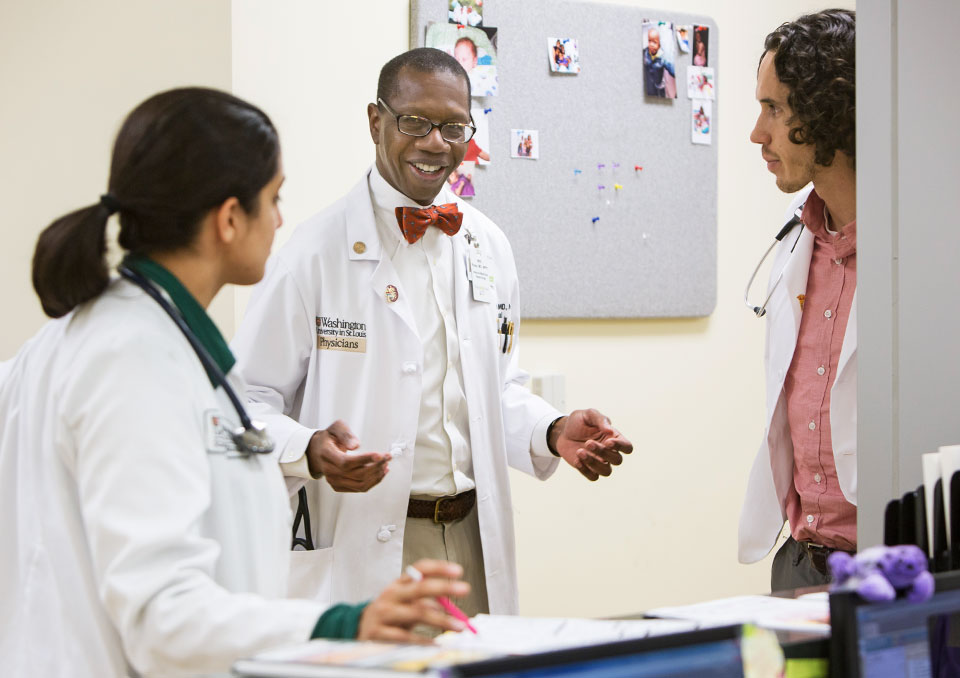
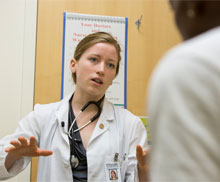
Reaffirming a career in medicine
The clinic often inspires students to make life-changing career choices. “Working at the clinic has given me an intimate view of the pressing social challenges we’re facing in health care in St. Louis,” said Kevin Baumgartner, a fourth-year student who spent two years there and is currently applying for residencies in emergency medicine.
“I helped take care of hard-working people who, through no fault of their own, have no jobs, insurance or transportation. I saw firsthand how our current health-care system fails our neediest citizens. This experience has helped motivate me to dedicate my career as a physician to improving safety-net health care and advocating for the vulnerable.”
Baumgartner recalled one clinic patient, in particular, who reaffirmed his career path: “An older man came in with what was almost certainly a blood clot in his leg. We urged him to go straight to the ER, by ambulance if necessary, as these clots can break off and lodge in the lung if not treated properly, which can cause respiratory failure, heart failure and even death. But the man refused to go. He had no insurance or money and didn’t think he could run the financial risk of a trip to the hospital. To this day, we don’t know what happened to him. This really brought home the message that routine life-saving care is beyond the reach of many of our citizens under the current system.”
Helping to coax medical students into primary care medicine is another benefit to the clinic, said Ross, a senior fellow at the Washington University Center for Health Policy. The nation is facing a shortage of primary care physicians — a problem, Ross and other experts say, that is expected to worsen in the coming years for various reasons, including aging doctors planning to retire and a sharp uptick in demand as many people become newly insured under the Affordable Care Act.
Additionally, Ross said, “there is an unfortunate stigma associated with going into family medicine. There’s an improper characterization of the medical student as not being as intellectually focused as the medical student wanting to specialize.”
Primary care doctors also earn significantly less than specialists, an important consideration for the students who graduate with six figures in medical school debt. Ross cited an annual salary of $150,000 to $200,000 for primary care physicians two years out of residency. By comparison, he said doctors with specialties could command $250,000 to $400,000 a year — and sometimes more — two years out of residency.
Regardless of medical specialty, learning about public health benefits all physicians, Ross said. And teaching it is socially and morally imperative for all medical schools. “It’s a shared responsibility,” he said. “It’s basic humanism.”
Working at the clinic is inspiring second-year students Sagar Mehta and Miriam Ben Abdallah — Saturday clinic board co-chairs and former student coordinators — to seriously consider going into primary care medicine. “You see firsthand that there is a need for primary care physicians,” Mehta said.

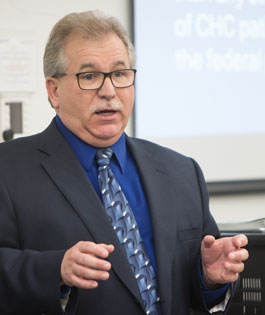
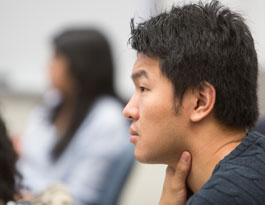
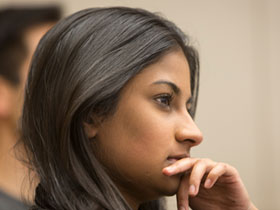
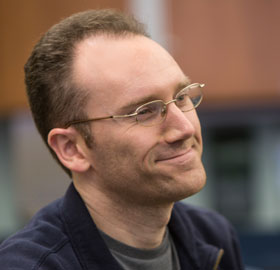
Maintaining a healthy focus
On any given Saturday morning, the student coordinators orient all the volunteers, oversee clinic flow and handle any complex patient concerns, research cost-effective medications and, perhaps the most challenging task of all, work the phones to give patients the best referrals for follow-up care. “It is not always easy,” Mehta said. “Resources in St. Louis for the disadvantaged are shrinking.” A case in point was last November’s shuttering of Saint Louis ConnectCare, one of the region’s top providers of outpatient specialized medical care for low-income residents. “You have to think off the top of your head,” Mehta said, “…[and] sometimes you make calls mid-week.”
Many times, the students successfully help patients. Other times, despite ardent efforts, patients’ problems linger or go untreated. This public health reality has taught Ben Abdallah one of the toughest, most important lessons learned during her medical schooling so far: The concept of “healthy packing,” or compartmentalizing distressful emotions to focus on “enthusiasm and optimism” needed to help future patients.
Like most weekends, the line outside of the clinic on the last Saturday morning in September was longer than could be accommodated. Two people were turned away. But that also meant nine people with limited health-care access received help. The clinic was their only option, Ben Abdallah said, adding:
“It’s important to focus on the successes because we want to keep moving forward and help as many people as possible. That is our mission.”






